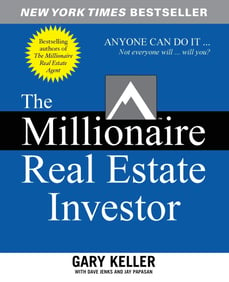The Millionaire Real Estate Investor was published in 2005 and ranks among the top ten real estate investment and leadership training books. The book was written by Gary Keller with contributions by Dave Jenks and Jay Papasan.
Keller is a self-made millionaire and founder of Keller Williams Realty International, the largest real estate franchise by agent count in the world. Founded in 1983, Keller Williams is part of Inc. Magazine’s top 5000 ranking.
Key Takeaways/Lessons Learned
- Millionaire real estate investors take luck out of their business by learning how to invest and investing to win
- Thinking Big: Big models with big goals lead to big success
- Five models of millionaire real estate investors: Net Worth, Financial, Network, Lead Generation, and Acquisition
- Dynamic trio of CTN: Criteria, Terms, Network
- Four stages of millionaire real estate investing: Think a Million, Buy a Million, Own a Million, Receive a Million
Summaries of Part One, Part Two, and Part Three
Gary Keller packs an amazing amount of useful, actionable information into the 432-page The Millionaire Real Estate Investor.
The following summaries aren’t meant to be exhaustive. Instead, we’ve pulled together some of the highlights that single-family real estate investors will find most useful.
Part One: Charting the Course
 Keller begins Part One by observing that champions take the luck out of the game because they’re masters at strategy and negotiation. In other words, there’s no such thing as “luck” in real estate investing, although every now and then investors may find some things that are beyond their control.
Keller begins Part One by observing that champions take the luck out of the game because they’re masters at strategy and negotiation. In other words, there’s no such thing as “luck” in real estate investing, although every now and then investors may find some things that are beyond their control.
Power of Big Goals
When an obstacle does occur, successful investors treat this as part of the natural learning curve to reaching their highest level of achievement. They use the process of thinking, planning, and producing to create a personal success formula for Big Goals:
- Big Goals
- Big Models
- Big Success
By applying the power of proven models over trial and error, investors are able to begin from achievement levels much further along the learning curve. Trial and error become systematic instead of erratic and shortens the path to the highest level of achievement.
Dynamic Trio of Investing - CTN
In “The Three Areas of Focus for the Millionaire Real Estate Investor” in Part One, Keller also discusses the importance of Pareto’s Principle, also known as the 80:20 Rule. The Rule states that 80% of our results come from 20% of our actions, so it’s critical for real estate investors to stay focused to be successful.
CTN – Criteria, Terms, Network – is referred to as the Dynamic Trio of Investing and is the best way for investors to stay focused:
Criteria
Defines what you buy and is a foundational piece of your investment strategy that isn’t open for negotiation. Criteria acts as an opportunity filter to identify the potential property purchases that offer the greatest opportunity and the least risk. Ultimately, criteria are used to identify properties with predictable value based on your investment style and strategy.
Terms
Define how you turn the prospective property that matches your criteria into a deal. Terms include negotiable factors such as offer price, down payment and interest rate, conveyance, occupancy and possession, and closing costs. When negotiating terms, it’s critical to remember that buying right means getting the right terms, because money is made in real estate going into the deal, not going out.
Network
Your network is made up of the people who help you locate the right deals and get them done. Many people mistakenly believe in the myth of the “Lone Wolf” investor, the entrepreneur who beats out other investors for deals. However, when Keller was researching material for The Millionaire Real Estate Investor, he found time and time again that the best real estate investors leveraged their relationships with people to send them opportunities, for mentoring, and for buying and maintaining properties.

The Four Stages of Growth on the Path to a Million
Millionaire real estate investors use a Foundational Model to chart their path to the first $1 million and beyond.
Think of the Foundational Model as the food pyramid to real estate investing success. The three equal sides of the triangle are labeled with the Dynamic Trio of Criteria, Terms, and Network. Within the triangle, starting from the base and working up to the point, are the four stages of growth:
- Think
- Buy
- Own
- Receive
At the very top of the Foundational Model triangle is “receiving.” Some investors may reach the point where they’re happy with the recurring cash flow they’ve built and decide to step out of the business and enjoy the fruits of their labor. Others may decide to wait, keep building their business and receive even more in the future.
MythUnderstandings
Deep down inside, most people know that they could and should be doing a much better job of building their wealth and financial freedom.
Most people also succumb to the myths – or rationalizations and excuses – of why they aren’t becoming true investors. That’s because, as Keller notes, fears are educated into us, and can, if we wish, be educated out.
The Millionaire Real Estate Investor lists three personal “mythunderstandings” and five mythunderstandings about investing. One of the greatest mythunderstandings is that most people genuinely believe that having a job will be enough to build financial wealth.
They’re conditioned to work hard for somebody else, be thrifty and save in a 401(k), and depend on Social Security to take care of the rest. However, time is not on the side of people who have this mythunderstanding. As workers age, incomes tend to peak during their 30s to 50s, then decline. Saving modestly during these working years leads to modest investments.
On the other hand, true investors use time in their favor. They think, buy, and own over and over again. By the time they’re in their 50s – the age when income for the average worker begins to decline – true investors have plenty of passive cash flow that keeps on increasing.

Part Two: The Four Stages
The second part of The Millionaire Real Estate Investor dives deep into the four stages of the Foundational Model Pyramid: Think, Buy, Own, Receive.
Think a Million
Since you’re reading this book review, the odds are you already know about the power of positive thinking and the importance of having a “Big Why” for being a real estate investor. The Big Why varies from one investor to the next, but always reaches down to a spiritual level.
Examples of Big Whys include seeking limitless opportunities that come with financial wealth, being as wealthy as you can be, or having the largest life possible for yourself and your family. The fact is there’s no right or wrong answer to what your personal Big Why should be.
Thinking also includes thinking big goals, thinking money, thinking net worth and real estate, thinking value and deals, and thinking action.
Keller also introduces us to Nina’s Rule and the importance of watching your posture. Nina is a personal trainer and explains how important posture is to our physical well-being. Small habits such as not standing or sitting straight eventually become ingrained in our behavior and eventually grow into big problems.
In the context of personal wealth, Keller uses Nina’s Rule to explain the importance of financial posture to our financial well-being. When little decisions such as spending a little less each day or returning one more phone call before you call it a night become habit-forming, they soon set the stage for bigger and better financial decisions.
Buy a Million
Money is made in real estate at the time the property is bought, not when it’s sold. The five models in this section – Net Worth, Financial, Network, Lead Generation, and Acquisition – are all proven models that let you learn from the mistakes of others:
- Net Worth Model shows that you must guide money along the path to the place that yields the greatest financial growth and net worth.
- Financial Model is comprised of Equity Buildup that increases your net worth through price appreciation combined with debt paydown, while Cash Flow Growth provides a steady stream of passive income.
- Network Model describes how to build your dream team with trusted members from your inner circle of mentors and partners, your support circle of professionals such as attorneys and real estate agents, and your service circle of people who perform property-specific tasks such as contractors or escrow officers.
- Lead Generation Model is used to generate an abundance of leads for investment properties and is building around the four core questions of: What am I looking for, Who can help me find it, How will I find the property or the people connected to it, and Which properties are the real opportunities?
- Acquisition Model focuses on buying right – and making your money going into the deal – and notes that Buy and Hold is the true financial wealth-building option because it harnesses the twin powers of Equity Buildup and Cash Flow Growth.

Own a Million
Keller lists 17 issues related to owning a million, categorizing them among the CTN of Criteria, Terms, and Network: Money and Protecting Your Primary Asset.
One of the most important takeaways from this section is that investors should think in units. A unit can be one single-family home, two apartments in a duplex, or 12 apartments in a larger multifamily building.
Each unit represents a cash flow stream on the income side. On the expense side, there’s time, focus, cost, and liability. Over time, millionaire real estate investors scale up and diversify their portfolios to maximize cash flow and minimize management. This diversification also provides protection during a short-term shift in the rental market.
Holding your money accountable by giving it a work ethic provides another unique perspective for real estate investors. The Millionaire Real Estate Investor lists Four Conditions of Money:
- Dead Money generates returns of 4% or less, which is at or below the real rate of inflation
- Safe Money generates modest returns of between 5% and 8%, just slightly above the real rate of inflation
- Healthy Money creates solid returns of between 9% and 12%
- Wealthy Money offers yields of between 13% and 20%, and is the way active real estate investors put money to work to build real wealth
Receive a Million
Other than inheriting money or winning the lottery, there are two ways people can receive $1 million annually: by holding a job that pays about $1.5 million a year (pre-tax), or by investing in real estate.
There are a few problems with holding a high-paying job like this. First, they’re few and far between. Then if you do find one, roughly 33% of your gross income goes toward taxes before you have the net income to invest. Third, when you leave the job the income goes away, too.
Keller points out that it’s much more realistic to receive $1 million each year by investing in real estate. That doesn’t mean going out and buying one hundred or more single-family homes for cash all in one day.
What Keller is illustrating in this section is the power of using low interest rates and leverage, cash flow, appreciation, and equity build to acquire enough income-producing real estate to receive $1 million in future annual cash flow and equity pullout.
Of course, in order to receive $1 million a year tomorrow, you have to have a plan today. As one millionaire real estate investor says:
“Make sure you understand what you want your portfolio to look like at the end. My future portfolio will be 250 houses. If all paid off, that would be $1.4 million in annual gross rental income, and when I’m 60 or 65 I can sell them and hold the notes. You want to get to a point where you have a business.”

Part Three: Staying on Top
Money and the world at large don’t care if you’re a millionaire. The responsibility for becoming a millionaire and staying there rests squarely on your shoulders.
The fact is that anyone can become a millionaire, but not everyone will. Most people in the world would like to have a million dollars, but they lack the focus and discipline to do what it takes to get there.
Remember the 80:20 Rule?
That law applies to would-be investors as well. 80% of people spend their time doing minor things that will create mediocre returns. Only the top 20% of real estate investors give their business focused time and focused effort to get to the top and stay there.
You can do that by building a financial track to run on:
- Establish a financial base camp by incorporating the Net Worth Model into your life.
- Protect your future by setting up an emergency fund, purchasing a home, obtaining adequate insurance, and creating an estate plan
- Fund your future by getting motivated, acquiring knowledge and power, generating leads, converting suspects into prospects, buying real estate investments, and gaining insights
- Stay the course with a specific plan of daily, weekly, monthly, and ongoing tasks to build an abundance of financial wealth
Profiles of Real-Life Millionaire Investors
Millionaire real estate investors can come from any social, economic, and cultural background. The book profiles 21 real-life millionaires and their investment journeys.
Here are some of the ways that investors have built their wealth through residential rental real estate:
Renata Circeo lives in Atlanta and has owned single-family and multifamily rental property for 16 years and specializes in buy and hold, fixer-uppers in the mid- and high-end home price range.
Renata calls herself a “classic overachiever”, admitting that she’s learned that things suffer when you spread yourself too thin. That’s why her focus is to concentrate on higher-end properties where she can maximize cash flow and long-term appreciation without having to deal with a huge number of units.
Jerry Clevenger is based in Kansas City and owns 53 single-family homes and a couple of commercial buildings. Jerry specializes in foreclosures and wholesaling, and in his words “when he started investing in real estate in the mid-1980s it was a fluke.”
At the beginning of his investing career, Jerry was climbing the corporate ladder in the banking industry and thought of real estate investing as a part-time money-making hobby. When he left the corporate world behind, Jerry made three times more in his first year as a full-time real estate investor than he had at the bank. He finds his best deals by working with real estate agents who comb the market for him.
Carlos Herbon and his wife live in Ogden, Utah, and have been investing in real estate for 15 years. They currently own 261 units and specialize in buy and hold.
The couple immigrated to the U.S. from Argentina in 1970 with only $120 dollars to their name. Realizing the U.S. was the land of opportunity, they immediately put their entrepreneurial skills to work by owning and operating a variety of business. But as Carlos says, “The way they’ve made it, and made it big, is through owning and renting properties.”
Is The Millionaire Real Estate Investor Worth Reading?
Keller knows that every deal and real estate market is unique, so he doesn’t offer a one-size-fits-all process. Instead, he provides an overarching roadmap for success that can be used with any asset class and in any market to become a millionaire real estate investor.
Strengths
- Discusses fundamental and core strategies for investing in real estate
- Explains common MythUnderstandings and how to overcome these obstacles on the path to a million
- Uses proven models for personal budgeting and investment financial planning
- Makes complex subjects easy to understand
- Offers worksheets for Personal Budget, Personal Balance Sheet, Criteria, and Cost of Repair
- Includes profiles of 21 real-life millionaire real estate investors and how they got to where they are today
Weaknesses
- At over 400 pages, The Millionaire Real Estate Investor isn’t a quick read
- Some readers may feel the book is overweight on motivation but lacks great ideas
- Written just before the last real estate crash, so some of the concepts regarding leverage may be too aggressive for long-term investors
- Investment concepts are oversimplified for intermediate and experienced real estate investors already on the way to making their first $1 million
Conclusion
While anyone can be a millionaire real estate investor, not everyone will. If you’re one of the doers, then definitely add The Millionaire Real Estate Investor to your library.
The book has actionable content for beginning, intermediate, and experienced real estate investors. Gary Keller does an excellent job of explaining the core fundamentals and strategies of real estate investing that you can easily customize for your own business.
If you're ready to put these financial principals into practice, check out Roofstock's resources to help you get started. We have the investment opportunities, strategies, and analysis you need to move forward toward your goals.









